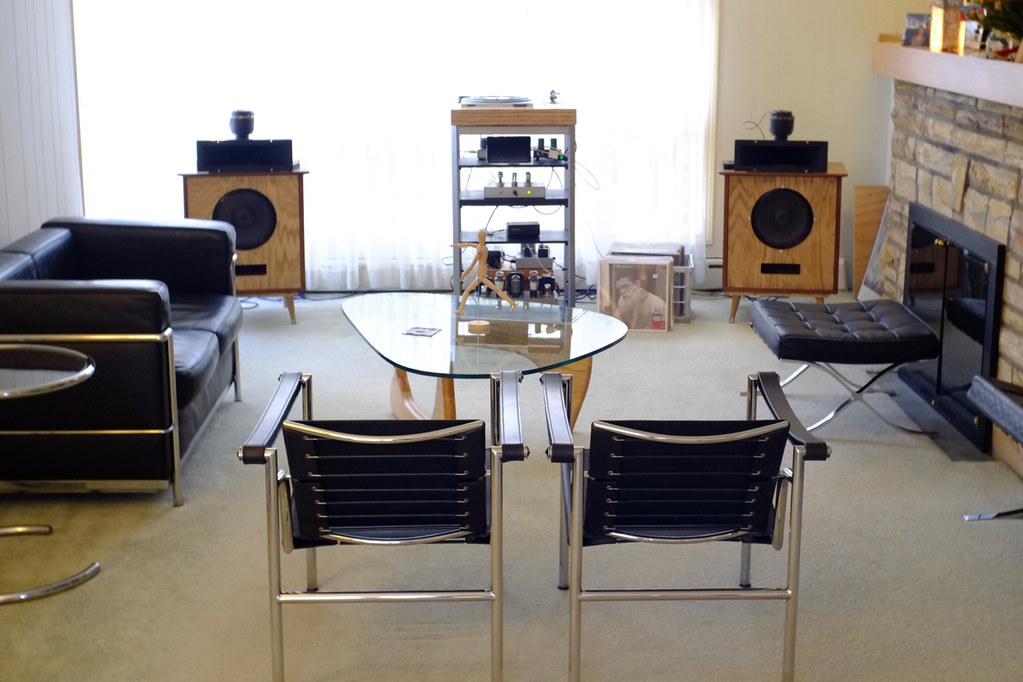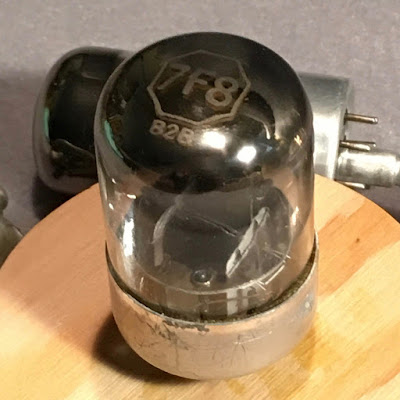+
This is a cumulative report on horns I listened to and tested from May 2016 until the end of 2017. All the tests were done through the mono hifi rig using the above Altec 802 compression driver fitted with a GPA 34852 diaphragm + an Altec 414A in a repurposed Altec 861 cabinet running in full-range mode tied together by a 6dB/octave high pass crossover/EQ hinged at 2500 Hz.
Altec 32A and 32C
 |
| Altec 32A (top) Altec 32C (bottom) |
The Altec 32A (metal) and 32C (plastic with ribs) horns are lineal descendants of the Western Electric 32A horn as found in the WE753 speaker system. I've had the plastic 32C since '09 and lived with the metal 32A for over a year and can say that these are the most sophisticated native 1" horns I've heard and owned to date.
Altec 32A
 |
| Altec 32A |
 |
| Altec 32A + 802 + 414A |
Metal or plastic?
It's ironic that the later plastic 32C sounds more vintage than the earlier metal 32A. Definitely, the longer throat of the earlier 32A and the type of material used for construction influence the sound. But in what capacity, I cannot surely define. The iPhone RTA results reinforce the cooler and more modern sound I hear from the metal 32A versus the warmer and sweeter plastic 32C.
The magnitude of difference is not great. Similar to the 20275 vs. 34852 Altec 1" aluminum diaphragms - distinct enough not to be used as a stereo pair but still excellent performers in their own right. However, those who are expecting a front-row presentation may find both these horns too laid back.
Watch out for roughly finished throat edges in the 32A which are detrimental to performance. So far all the plastic 32Cs I've seen have very smooth throats.
Emilar
As soon as I landed in the US in May 2016, I tried to collect the Emilar horns talked up by Joe Roberts in his war against the devil's trumpets before they became unaffordable. 😉
EH1210
 |
| Emilar EH1210 |
 |
| Emilar EH1210 + 802 + 414A |
This wasn't recommended by J-Rob but it was cheap enough to try. The EH1210 has the most extended high frequency response according to the iPhone RTA but subjectively it was the least refined sounding horn in this group. I think one can do much better with some modern offerings, see the last entry below.
Emilar "Bowtie" EH800 and EH500
 |
| Emilar EH500 (left) + Emilar "Bowtie" EH800 (right) |
WARNING: these two Emilar horns are heavy cast jobs, doing the audiophile knuckle test can result in serious injury! 😃
EH800
 |
| Emilar "Bowtie" EH800 |
 |
| EH800 + 802 + 414A |
If you are looking for a modern sounding horn with a more forward presentation but without the shout and distortion of the Altec 811, then this is the horn for you. Exciting sound but guaranteed not to make your ears bleed.
I think the low end cut-off at 800 Hz spec is a bit optimistic. For maximum satisfaction start around 1200 Hz and work upwards.
EH500
 |
| EH500 |
 |
| EH500 + 802 + 414A |
This is a native 2" horn with a finely machined 1" - 2" throat adaptor. Once again I find the 500 Hz cut-off an overestimation for a horn of this size. I'd start crossing around 900 Hz and up.
My ears do not agree with the iPhone RTA. I found this horn to be mellower than the EH800 "Bowtie." The tonal balance of the EH500 is somewhere in between the Altec 32A/B/C and the EH800.
EH500 in Large Format Mode
 |
| EH500 sans adaptor + Renkus-Heinz SSD3301 |
With the JEL N1600 XO in tow, I removed the 1"-2" throat adapter and bolted the 2" exit Renkus-Heinz SSD3301 directly to the horn to sample large format tones. I got juicy mids and smooth highs from this combo.
Late addition:
Faital Pro STH100
 |
| Faital Pro STH100 |
I wanted to sample what can be had off the shelf at Parts Express for under $100 and ordered a pair of these small aluminum tractrix horns by Faital Pro.
 |
| STH100 + 802 + 414A* *RTA was done at a later date in another location, hence the difference in low frequency response |
With the Altec 414A running full range and the STH100/802 combo crossed at approximately 2500 Hz, I got very clean (if a bit dry) high frequency harmonic augmentation with no nastiness at all. To my ears, this tractrix horn is preferable to the EH1210.
CODA
For the past 4 years, I've been blogging about horns and compression drivers. Justifiably, the horn/driver combo seasons the speaker system's sonic flavor. However, these components only cover the upper three octaves of the audio band (mostly harmonic overtones). I would be remiss if I didn't stress the greater importance of the Altec 12" 414 woofer/midrange because it is tasked to reproduce most, if not all, of the fundamental notes in music from 30 Hz to 4000 Hz. That's seven octaves, practically the frequency range of a piano.
I've been trying, but so far haven't found alternative 15" or 12" woofers that play the midrange as well as the Altec 414. The good news is, Bill Hanuschak of Great Plains Audio told me last year that they still re-cone 414s and their product page lists an Alnico 414-8B(16B).





























